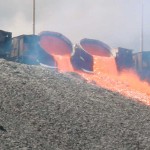

 Jaw Crusher is primary used for crushing big lumps of slag from the slag pot. As the slag fed into the jaw crusher heavy duty Hardened Jaw crushes the big lumps of slag into medium size which then goes to next process. Jaw Crusher is also used by various industries for crushing coal, rock, refractory, glass & stone etc.
Jaw Crusher is primary used for crushing big lumps of slag from the slag pot. As the slag fed into the jaw crusher heavy duty Hardened Jaw crushes the big lumps of slag into medium size which then goes to next process. Jaw Crusher is also used by various industries for crushing coal, rock, refractory, glass & stone etc.
Roller crusher is ideally used for crushing slag and is secondary process after jaw crusher. The material after passes through jaw crusher fed through roller crusher. Material crushed by roller crusher will now be the mixture of metal contaminates & sand contaminates which now goes to third process. Roller crusher is fully fabricated M.S. & Tank Plate with five beaters & two adjustable weights to absorb the heavy strokes inside the machine. Roller crusher is also successfully operated for or Crushing coal, stone & glass etc. Roller crusher is used by various steel plants without any maintenance & is easy to operate.
Ball mill is successfully used for polishing. Crushing, grinding & mixing of various types of products. Separated iron particles from magnetic separator which is not 100% pure metal because few sand particles are still attached with iron particles due to rusted material. But you will get 9o to l00% pure metal from the waste product of steel furnace. As the material from magnetic separator fed through the ball mill drum, heavy duty balls inside the drum crushes the iron particles & the sand particles attached with iron particles become separated and came out through the holes on the outer shell of the ball mill drum & the pure iron will be left inside the drum.
Slag Basics
Slag is a partially vitreous by-product of smelting ore to separate the metal fraction from the unwanted fraction. It can usually be considered to be a mixture of metal oxides and silicon dioxide. However, slags can contain metal sulfides (see also matte) and metal atoms in the elemental form. While slags are generally used as a waste removal mechanism in metal smelting, they can also serve other purposes, such as assisting in the temperature control of the smelting; and also minimizing any re-oxidation of the final liquid metal product before the molten metal is removed from the furnace and used to make solid metal.
Modern slag uses
Ground granulated slag is often used in concrete in combination with Portland cement as part of blended cement. Ground granulated slag reacts with water to produce cementitious properties. Concrete containing ground granulated slag develops strength over a longer period, leading to reduced permeability and better durability. Since the unit volume of Portland cement is reduced, this concrete is less vulnerable to alkali-silica and sulfate attack.
When iron ore is heated in a blast furnace, the impurities or ‘slag’, which include large quantities of calcium and silica, become molten and are separated from the raw iron.
As the slag is channeled out of the furnace, thousands of gallons of water are poured over it. This rapid cooling, often from a temperature of around 2,600°C, is the start of the granulating process. This process causes several chemical reactions to take place within the material, and gives the slag its cementitious properties.
The water carries the slag in its slurry format to a large agitation tank, from where it is pumped along a piping system into a number of gravel based filter beds. The filter beds then retain the slag granules, while the water filters away and is returned to the system.
When the filtering process is complete, the remaining slag granules, which now give the appearance of coarse beach sand, can be scooped out of the filter bed and transferred to the grinding facility where they are ground into particles that are finer than Portland cement.
This previously unwanted recycled product is used in the manufacture of high performance concretes, especially those used in the construction of bridges and coastal features, where its low permeability and greater resistance to chlorides and sulfates can help to reduce corrosive action and deterioration of the structure.